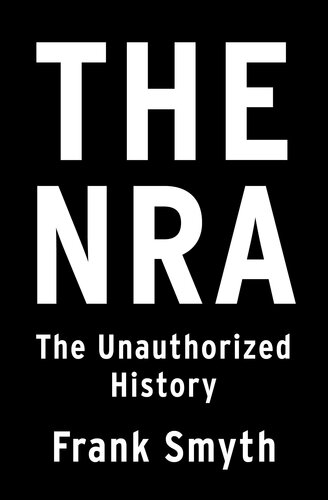
The NRA
The Unauthorized History
کتاب های مرتبط
- اطلاعات
- نقد و بررسی
- دیدگاه کاربران
نقد و بررسی

March 30, 2020
Journalist Smyth debuts with a balanced and accessible history of the National Rifle Association. Both a gun owner and a supporter of gun control measures, Smyth critiques the modern NRA’s “absolutist” stances against gun control, but is primarily interested in tracing the organization’s evolution from a Reconstruction-era group in New York City interested in militia preparedness to its early-20th-century emergence as a national organization focused on educating sportsmen about marksmanship and gun safety. Smyth reveals that the NRA had a long history of supporting state and federal gun control measures, including those aimed at limiting access to firearms for convicted felons, people connected to organized crime, and political radicals. Beginning in the late 1960s, however, the NRA started delving into partisan politics, increasingly aligning itself with the Republican Party. Smyth points to the organization’s 1977 annual meeting in Cincinnati, when strident anti–gun control activists Harlon Carter and Neal Knox orchestrated a series of votes that installed Carter in the top leadership post, as the first step in the remaking of the NRA into a well-funded lobbying organization with the political clout to weather public outrage over Columbine, Sandy Hook, and other mass shootings. Smyth chronicles the NRA’s internal debates with painstaking detail, though the organization’s secrecy prevents jaw-dropping revelations. Readers tired of partisanship on both sides of the gun control debate will appreciate this straightforward overview.

A gun-owning investigative journalist's history of the National Rifle Association. Smyth admits he's a "Fudd," a derisive NRA term for a gun owner who supports gun regulations. As befits that nuanced stance, the author offers a measured, scrupulously researched political history that shows how the NRA has evolved from an organization promoting rifle marksmanship to an unrelenting foe of all limits on guns. Smyth blends a great-man approach to history with an instinct for following money trails, telling the story of the NRA largely through its leaders and how their financial or other decisions shaped the group and the nation. First came founders George Wood Wingate and William Conant Church, former Union officers who, dismayed by "the appalling lack of marksmanship on both sides in the Civil War," started the group during Reconstruction. The 20th century brought presidents like Harlon B. Carter, a convicted murderer whose conviction was overturned on appeal; and Marion Hammer, the first female president, who, after the 1992 Rodney King riots, wrote an article called "You loot--we shoot" for NRA publication American Rifleman. The current leader, Wayne LaPierre, has recruited celebrities like Charlton Heston and turned the group into a deep-pocketed political titan that gave $54.4 million to candidates in the 2016 elections. After the Columbine massacre in 1999, the NRA developed "a playbook" for responding to demands for gun controls, which included tactics such as: "Deflect by saying this is not a time to discuss politics but a time to mourn." Many such unsavory details will be maddening to gun rights absolutists, but Smyth avoids quoting anonymous sources, drawing on well-documented material and staying neutral (and above accusations of bias) on controversies. The result is an authoritative, no-frills story, long on solid information but short on the color and passion that might have made it sing. A fair and balanced portrait of one of America's most controversial organizations. (first printing of 200,000) (Adult, nonfiction, history, political history, organizations, National Rifle Association)
COPYRIGHT(2020) Kirkus Reviews, ALL RIGHTS RESERVED. (Online Review)

April 10, 2020
Journalist Smyth debuts with a balanced history of the National Rifle Association (NRA), staring with its founding by former soldiers George Wood Wingate and William Conant Church after the Civil War as an organization dedicated to marksmanship. Smyth shows how the association was initially supportive of gun control, rifle training, and conservation up until the 1970s, until pivotal movements--including the "Cincinnati Revolt" of 1977 along with gun advocate (and convicted murderer) Harlon Carter assuming leadership of the association--led to its rapid transformation into a politically conservative, Republican-controlled lobbying organization. Notably, Smyth describes how the NRA developed enough political clout to counter popular gun control laws and deflect public outrage after mass shootings. He also covers the tenures of NRA leaders such as Marion Hammer, the first woman to hold the position of NRA president, and CEO Wayne LaPierre. The author, a gun owner and a supporter of gun control, thoroughly documents the NRA's internal debates, tortuous efforts to rewrite its public image and history, and recent efforts to recruit celebrity advocates. VERDICT The book is meticulously detailed, sometimes overly so, including investigations into the NRA's internal debates and parliamentary process. Still, libraries looking for a nonpartisan history of the organization will be well-served.--Edwin Burgess, Kansas City, KS
Copyright 2020 Library Journal, LLC Used with permission.

October 1, 2019
Award-winning independent journalist Smyth offers a history of the National Rifle Association, showing that while the NRA now opposes any attempt to restrict guns, it was once focused primarily on marksmanship and supportive of most governmental gun-control measures. That Smyth is a gun owner and Second Amendment adherent who also worked as an arms-trafficking investigator for Human Rights Watch suggests the kind of balance he should bring to this story.
Copyright 2019 Library Journal, LLC Used with permission.

























دیدگاه کاربران